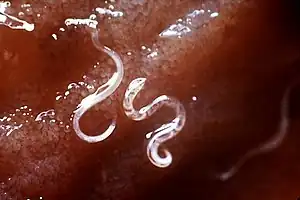Rhabditia
Subclass Rhabditia is mostly composed of parasitic nematodes (particularly in the Strongylida), though there are some free-living species as well (particularly in the Rhabditida). Phasmids (posterior sensory structures) are well-developed, while amphids (anterior sensory structures) are poorly developed or absent in this group.
| Rhabditia | |
|---|---|
 | |
| Ancylostoma caninum hookworms (Strongylida: Ancylostomidae) | |
| Scientific classification | |
| Domain: | Eukaryota |
| Kingdom: | Animalia |
| Phylum: | Nematoda |
| Class: | Chromadorea |
| Subclass: | Rhabditia |
| Orders | |
|
Rhabditida | |
| Synonyms | |
|
Rhabditina | |
In an alternate classification system, they are treated as suborder Rhabditina, with the orders listed here being ranked as infraorders. Also, the Diplogasterida, which are sometimes considered a monotypic subclass, are probably better placed in the Rhabditia. On the other hand, the old placement of the Ascaridida in Rhabditia instead of Spiruria seems unwarranted. The Rhabditida contain a number of families which are probably better placed in the Tylenchia; alternatively, the latter group may entirely be merged with the Rhabditia.[1]
See also
References
- Tree of Life Web Project (ToL) (2002b): Nematoda. Version of 2002-JAN-01. Retrieved 2008-NOV-02.ToL (2002)